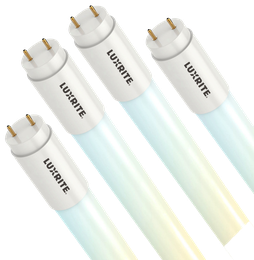FREE shipping on orders over $49!* Details
- All Products
- Lighting
- Lighting Accessories
- Light Bulbs
- Fluorescent Tubes
Fluorescent Tubes
8 Results
Sort by:
Price
8 Results
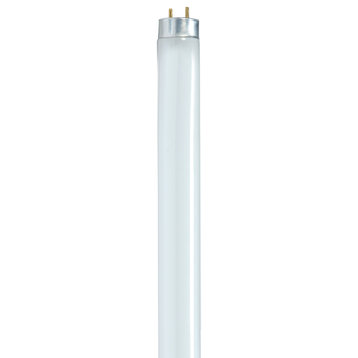
Satco Lighting S8433 Single 17 Watt 24"W T8 Bi Pin Fluorescent - Frostedby Satco Lighting
$15
Free Shipping
Features Pack of (1) bulbs Not capable of being dimmed Rated for dry locations Electrical Specifications Bulb Base: Bi Pin Bulb Type: Fluorescent Bulb Shape: T8 Wattage: 17 watts Voltage: 120 volts Dimensions: Width: 23-3/4"
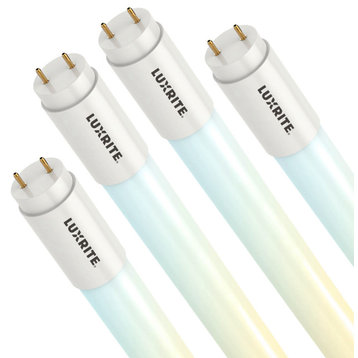
Luxrite 4FT T8 LED Tube Lights 5CCT Type B Up to 2250LM UL DLC 4-Packby Luxrite
$65
Free Shipping
5 COLOR OPTIONS - Not able to decide which color you want in your space? Each t8 LED light tube has an adjustable color switch attached which can be used to change between 5 cct color temperatures. Enjoy your lights at 3000K soft white, 3500K natural white, 4000K cool white, 5000K bright white, or 6500K daylight. Change your lights at any time without having to try traditional single color tube light bulbs until you get just the right look.
TUNABLE BRIGHTNESS - An adjustable option that allows you to control how much energy and how bright you want your lights to be. Each t8 LED bulbs 4 foot light has a 3 wattage switch which offer the ability to go from 12 watts, 18 watts, or 18 watts of power. With each adjustment the amount of light produced will also change. The 12W setting will offer 1620 lumens, 15W offers 1950 lumens, and 18W offers the brightest setting at 2250 lumens. Pick your preference based on location and room size.
BALLAST BYPASS - Hardwire these 4ft LED bulbs directly since these can handle single end or dual end powered connections. Capable of both 120V through 277V wiring installations and can work with existing shunted lamp holders/tombstones when dual end connected. If using a single end install, you will need to use non-shunted lamp holders/tombstones.
CONTINUOUS LIGHT - Built with an astounding 50,000 hours of lifetime which means no replacement will be needed for years. Each 4ft tube LED lights has a frosted cover and is shatterproof which allows for safer installation compared to glass fluorescent lights. Use these in your shop, garage, workshop, office, basement, indoor, outdoor, or anywhere in your home or business requiring t8 LED lamps. These are the ideal f32t8 LED replacement to traditional fluorescent tube lights.;
RELIABLE LIGHTING - Zero flickering light, zero delay, and zero worries with 4" LED light bulbs that provide quality indoor and outdoor lighting. Each LED tube light is quick to install, has a 5cct tunable switch, damp location rated, comes UL Classified for your safety, DLC listed for reliability, works in direct wire ballast bypass single or double end installations, is g13 2-pin base, and backed by a 5 YEAR WARRANTY.
TUNABLE BRIGHTNESS - An adjustable option that allows you to control how much energy and how bright you want your lights to be. Each t8 LED bulbs 4 foot light has a 3 wattage switch which offer the ability to go from 12 watts, 18 watts, or 18 watts of power. With each adjustment the amount of light produced will also change. The 12W setting will offer 1620 lumens, 15W offers 1950 lumens, and 18W offers the brightest setting at 2250 lumens. Pick your preference based on location and room size.
BALLAST BYPASS - Hardwire these 4ft LED bulbs directly since these can handle single end or dual end powered connections. Capable of both 120V through 277V wiring installations and can work with existing shunted lamp holders/tombstones when dual end connected. If using a single end install, you will need to use non-shunted lamp holders/tombstones.
CONTINUOUS LIGHT - Built with an astounding 50,000 hours of lifetime which means no replacement will be needed for years. Each 4ft tube LED lights has a frosted cover and is shatterproof which allows for safer installation compared to glass fluorescent lights. Use these in your shop, garage, workshop, office, basement, indoor, outdoor, or anywhere in your home or business requiring t8 LED lamps. These are the ideal f32t8 LED replacement to traditional fluorescent tube lights.;
RELIABLE LIGHTING - Zero flickering light, zero delay, and zero worries with 4" LED light bulbs that provide quality indoor and outdoor lighting. Each LED tube light is quick to install, has a 5cct tunable switch, damp location rated, comes UL Classified for your safety, DLC listed for reliability, works in direct wire ballast bypass single or double end installations, is g13 2-pin base, and backed by a 5 YEAR WARRANTY.
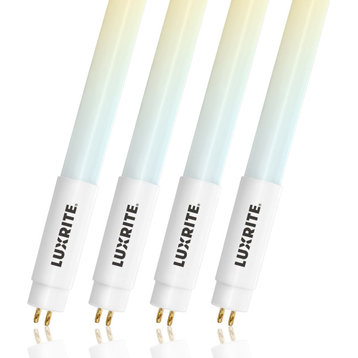
Luxrite 4FT T5 LED Tube Lights 24W 4CCT Ballast Bypass 3200LM 4-Packby Luxrite
$86
Free Shipping
4 COLOR OPTIONS - Not able to decide which color you want in your space? These t5 LED bulbs have an adjustable color switch attached which can be used to change between 4cct color temperatures. Enjoy your lights at 3500K natural white, 4000K cool white, 5000K bright white, or 6500K daylight. Change your lights at any time without having to try traditional single color tube light bulbs until you get just the right look.
BRIGHT - Every LED tube light provides your 4 foot light fixtures with 3200 lumens of crisp, quality light that will brighten your space more efficiently than your standard 48 inch fluorescent tube lights, equivalent to 133 lm/W. Use these in your shop, garage, workshop, office, basement, indoor, outdoor, or anywhere in your home requiring an led replacement for fluorescent tubes.
BALLAST BYPASS - Hardwire each t5 LED bulb directly since these can handle single end or dual end powered connections. Capable of both 120V through 277V wiring installations and can work with existing shunted lamp holders/tombstones when dual end connected. If using a single end install, you will need to use non-shunted lamp holders/tombstones.
CONTINUOUS LIGHT - Built with an astounding 50,000 hours of lifetime which means no replacement will be needed for years. Each 4ft tube LED lights has a frosted cover and is shatterproof which allows for safer installation compared to glass fluorescent lights. Use these in your shop, garage, workshop, office, basement, indoor, outdoor, or anywhere in your home or business requiring a t5ho bulb. These are the ideal f54t5 LED replacement to traditional fluorescent tube light bulbs.
RELIABLE LIGHTING - Zero flickering light, zero delay, and zero worries with 4ft LED ballast bypass bulbs that provide quality indoor and outdoor lighting. These T5 bulbs are quick to install, have a 4 cct tunable switch, 45.79 inch length pin to pin, damp location rated, UL Classified for your safety, DLC listed for reliability, works in direct wire ballast bypass single or double end installations, is g5 2-pin base, and backed by a 5 YEAR WARRANTY.
BRIGHT - Every LED tube light provides your 4 foot light fixtures with 3200 lumens of crisp, quality light that will brighten your space more efficiently than your standard 48 inch fluorescent tube lights, equivalent to 133 lm/W. Use these in your shop, garage, workshop, office, basement, indoor, outdoor, or anywhere in your home requiring an led replacement for fluorescent tubes.
BALLAST BYPASS - Hardwire each t5 LED bulb directly since these can handle single end or dual end powered connections. Capable of both 120V through 277V wiring installations and can work with existing shunted lamp holders/tombstones when dual end connected. If using a single end install, you will need to use non-shunted lamp holders/tombstones.
CONTINUOUS LIGHT - Built with an astounding 50,000 hours of lifetime which means no replacement will be needed for years. Each 4ft tube LED lights has a frosted cover and is shatterproof which allows for safer installation compared to glass fluorescent lights. Use these in your shop, garage, workshop, office, basement, indoor, outdoor, or anywhere in your home or business requiring a t5ho bulb. These are the ideal f54t5 LED replacement to traditional fluorescent tube light bulbs.
RELIABLE LIGHTING - Zero flickering light, zero delay, and zero worries with 4ft LED ballast bypass bulbs that provide quality indoor and outdoor lighting. These T5 bulbs are quick to install, have a 4 cct tunable switch, 45.79 inch length pin to pin, damp location rated, UL Classified for your safety, DLC listed for reliability, works in direct wire ballast bypass single or double end installations, is g5 2-pin base, and backed by a 5 YEAR WARRANTY.
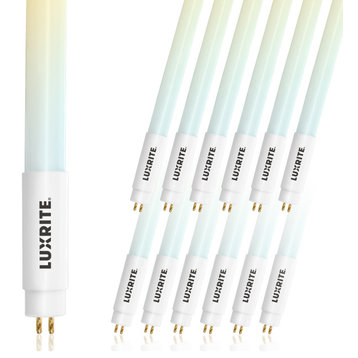
Luxrite 12-Pack 4FT T5 LED Tube Light 24W 4CCT Ballast Bypass 3200LMby Luxrite
$207
Free Shipping
4 COLOR OPTIONS - Not able to decide which color you want in your space? These t5 LED bulbs have an adjustable color switch attached which can be used to change between 4cct color temperatures. Enjoy your lights at 3500K natural white, 4000K cool white, 5000K bright white, or 6500K daylight. Change your lights at any time without having to try traditional single color tube light bulbs until you get just the right look.
BRIGHT - Every LED tube light provides your 4 foot light fixtures with 3200 lumens of crisp, quality light that will brighten your space more efficiently than your standard 48 inch fluorescent tube lights, equivalent to 133 lm/W. Use these in your shop, garage, workshop, office, basement, indoor, outdoor, or anywhere in your home requiring an led replacement for fluorescent tubes.
BALLAST BYPASS - Hardwire each t5 LED bulb directly since these can handle single end or dual end powered connections. Capable of both 120V through 277V wiring installations and can work with existing shunted lamp holders/tombstones when dual end connected. If using a single end install, you will need to use non-shunted lamp holders/tombstones.
CONTINUOUS LIGHT - Built with an astounding 50,000 hours of lifetime which means no replacement will be needed for years. Each 4ft tube LED lights has a frosted cover and is shatterproof which allows for safer installation compared to glass fluorescent lights. Use these in your shop, garage, workshop, office, basement, indoor, outdoor, or anywhere in your home or business requiring a t5ho bulb. These are the ideal f54t5 LED replacement to traditional fluorescent tube light bulbs.
RELIABLE LIGHTING - Zero flickering light, zero delay, and zero worries with 4ft LED ballast bypass bulbs that provide quality indoor and outdoor lighting. These T5 bulbs are quick to install, have a 4 cct tunable switch, 45.79 inch length pin to pin, damp location rated, UL Classified for your safety, DLC listed for reliability, works in direct wire ballast bypass single or double end installations, is g5 2-pin base, and backed by a 5 YEAR WARRANTY.
BRIGHT - Every LED tube light provides your 4 foot light fixtures with 3200 lumens of crisp, quality light that will brighten your space more efficiently than your standard 48 inch fluorescent tube lights, equivalent to 133 lm/W. Use these in your shop, garage, workshop, office, basement, indoor, outdoor, or anywhere in your home requiring an led replacement for fluorescent tubes.
BALLAST BYPASS - Hardwire each t5 LED bulb directly since these can handle single end or dual end powered connections. Capable of both 120V through 277V wiring installations and can work with existing shunted lamp holders/tombstones when dual end connected. If using a single end install, you will need to use non-shunted lamp holders/tombstones.
CONTINUOUS LIGHT - Built with an astounding 50,000 hours of lifetime which means no replacement will be needed for years. Each 4ft tube LED lights has a frosted cover and is shatterproof which allows for safer installation compared to glass fluorescent lights. Use these in your shop, garage, workshop, office, basement, indoor, outdoor, or anywhere in your home or business requiring a t5ho bulb. These are the ideal f54t5 LED replacement to traditional fluorescent tube light bulbs.
RELIABLE LIGHTING - Zero flickering light, zero delay, and zero worries with 4ft LED ballast bypass bulbs that provide quality indoor and outdoor lighting. These T5 bulbs are quick to install, have a 4 cct tunable switch, 45.79 inch length pin to pin, damp location rated, UL Classified for your safety, DLC listed for reliability, works in direct wire ballast bypass single or double end installations, is g5 2-pin base, and backed by a 5 YEAR WARRANTY.
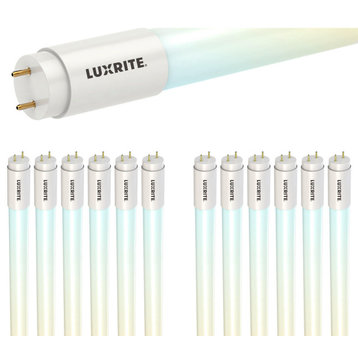
Luxrite 12-Pack 4FT T8 LED Tube Lights 5CCT Type B Up to 2250LM UL DLCby Luxrite
$148
Free Shipping
5 COLOR OPTIONS - Not able to decide which color you want in your space? Each t8 LED light tube has an adjustable color switch attached which can be used to change between 5 cct color temperatures. Enjoy your lights at 3000K soft white, 3500K natural white, 4000K cool white, 5000K bright white, or 6500K daylight. Change your lights at any time without having to try traditional single color tube light bulbs until you get just the right look.
TUNABLE BRIGHTNESS - An adjustable option that allows you to control how much energy and how bright you want your lights to be. Each t8 LED bulbs 4 foot light has a 3 wattage switch which offer the ability to go from 12 watts, 18 watts, or 18 watts of power. With each adjustment the amount of light produced will also change. The 12W setting will offer 1620 lumens, 15W offers 1950 lumens, and 18W offers the brightest setting at 2250 lumens. Pick your preference based on location and room size.
BALLAST BYPASS - Hardwire these 4ft LED bulbs directly since these can handle single end or dual end powered connections. Capable of both 120V through 277V wiring installations and can work with existing shunted lamp holders/tombstones when dual end connected. If using a single end install, you will need to use non-shunted lamp holders/tombstones.
CONTINUOUS LIGHT - Built with an astounding 50,000 hours of lifetime which means no replacement will be needed for years. Each 4ft tube LED lights has a frosted cover and is shatterproof which allows for safer installation compared to glass fluorescent lights. Use these in your shop, garage, workshop, office, basement, indoor, outdoor, or anywhere in your home or business requiring t8 LED lamps. These are the ideal f32t8 LED replacement to traditional fluorescent tube lights.;
RELIABLE LIGHTING - Zero flickering light, zero delay, and zero worries with 4" LED light bulbs that provide quality indoor and outdoor lighting. Each LED tube light is quick to install, has a 5cct tunable switch, damp location rated, comes UL Classified for your safety, DLC listed for reliability, works in direct wire ballast bypass single or double end installations, is g13 2-pin base, and backed by a 5 YEAR WARRANTY.
TUNABLE BRIGHTNESS - An adjustable option that allows you to control how much energy and how bright you want your lights to be. Each t8 LED bulbs 4 foot light has a 3 wattage switch which offer the ability to go from 12 watts, 18 watts, or 18 watts of power. With each adjustment the amount of light produced will also change. The 12W setting will offer 1620 lumens, 15W offers 1950 lumens, and 18W offers the brightest setting at 2250 lumens. Pick your preference based on location and room size.
BALLAST BYPASS - Hardwire these 4ft LED bulbs directly since these can handle single end or dual end powered connections. Capable of both 120V through 277V wiring installations and can work with existing shunted lamp holders/tombstones when dual end connected. If using a single end install, you will need to use non-shunted lamp holders/tombstones.
CONTINUOUS LIGHT - Built with an astounding 50,000 hours of lifetime which means no replacement will be needed for years. Each 4ft tube LED lights has a frosted cover and is shatterproof which allows for safer installation compared to glass fluorescent lights. Use these in your shop, garage, workshop, office, basement, indoor, outdoor, or anywhere in your home or business requiring t8 LED lamps. These are the ideal f32t8 LED replacement to traditional fluorescent tube lights.;
RELIABLE LIGHTING - Zero flickering light, zero delay, and zero worries with 4" LED light bulbs that provide quality indoor and outdoor lighting. Each LED tube light is quick to install, has a 5cct tunable switch, damp location rated, comes UL Classified for your safety, DLC listed for reliability, works in direct wire ballast bypass single or double end installations, is g13 2-pin base, and backed by a 5 YEAR WARRANTY.
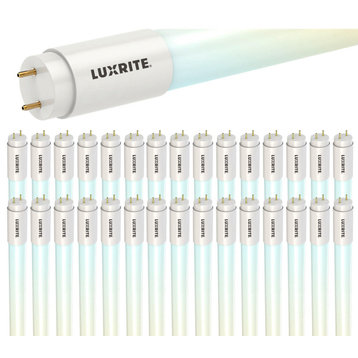
Luxrite 30-Pack 4FT T8 LED Tube Lights 5CCT Type B Up to 2250LM UL DLCby Luxrite
$374
Free Shipping
5 COLOR OPTIONS - Not able to decide which color you want in your space? Each t8 LED light tube has an adjustable color switch attached which can be used to change between 5 cct color temperatures. Enjoy your lights at 3000K soft white, 3500K natural white, 4000K cool white, 5000K bright white, or 6500K daylight. Change your lights at any time without having to try traditional single color tube light bulbs until you get just the right look.
TUNABLE BRIGHTNESS - An adjustable option that allows you to control how much energy and how bright you want your lights to be. Each t8 LED bulbs 4 foot light has a 3 wattage switch which offer the ability to go from 12 watts, 18 watts, or 18 watts of power. With each adjustment the amount of light produced will also change. The 12W setting will offer 1620 lumens, 15W offers 1950 lumens, and 18W offers the brightest setting at 2250 lumens. Pick your preference based on location and room size.
BALLAST BYPASS - Hardwire these 4ft LED bulbs directly since these can handle single end or dual end powered connections. Capable of both 120V through 277V wiring installations and can work with existing shunted lamp holders/tombstones when dual end connected. If using a single end install, you will need to use non-shunted lamp holders/tombstones.
CONTINUOUS LIGHT - Built with an astounding 50,000 hours of lifetime which means no replacement will be needed for years. Each 4ft tube LED lights has a frosted cover and is shatterproof which allows for safer installation compared to glass fluorescent lights. Use these in your shop, garage, workshop, office, basement, indoor, outdoor, or anywhere in your home or business requiring t8 LED lamps. These are the ideal f32t8 LED replacement to traditional fluorescent tube lights.;
RELIABLE LIGHTING - Zero flickering light, zero delay, and zero worries with 4" LED light bulbs that provide quality indoor and outdoor lighting. Each LED tube light is quick to install, has a 5cct tunable switch, damp location rated, comes UL Classified for your safety, DLC listed for reliability, works in direct wire ballast bypass single or double end installations, is g13 2-pin base, and backed by a 5 YEAR WARRANTY.
TUNABLE BRIGHTNESS - An adjustable option that allows you to control how much energy and how bright you want your lights to be. Each t8 LED bulbs 4 foot light has a 3 wattage switch which offer the ability to go from 12 watts, 18 watts, or 18 watts of power. With each adjustment the amount of light produced will also change. The 12W setting will offer 1620 lumens, 15W offers 1950 lumens, and 18W offers the brightest setting at 2250 lumens. Pick your preference based on location and room size.
BALLAST BYPASS - Hardwire these 4ft LED bulbs directly since these can handle single end or dual end powered connections. Capable of both 120V through 277V wiring installations and can work with existing shunted lamp holders/tombstones when dual end connected. If using a single end install, you will need to use non-shunted lamp holders/tombstones.
CONTINUOUS LIGHT - Built with an astounding 50,000 hours of lifetime which means no replacement will be needed for years. Each 4ft tube LED lights has a frosted cover and is shatterproof which allows for safer installation compared to glass fluorescent lights. Use these in your shop, garage, workshop, office, basement, indoor, outdoor, or anywhere in your home or business requiring t8 LED lamps. These are the ideal f32t8 LED replacement to traditional fluorescent tube lights.;
RELIABLE LIGHTING - Zero flickering light, zero delay, and zero worries with 4" LED light bulbs that provide quality indoor and outdoor lighting. Each LED tube light is quick to install, has a 5cct tunable switch, damp location rated, comes UL Classified for your safety, DLC listed for reliability, works in direct wire ballast bypass single or double end installations, is g13 2-pin base, and backed by a 5 YEAR WARRANTY.
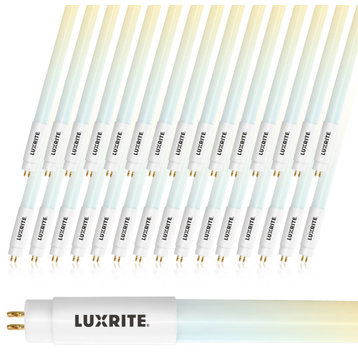
Luxrite 30-Pack 4FT T5 LED Tube Light 24W 4CCT Ballast Bypass 3200LMby Luxrite
$466
Free Shipping
4 COLOR OPTIONS - Not able to decide which color you want in your space? These t5 LED bulbs have an adjustable color switch attached which can be used to change between 4cct color temperatures. Enjoy your lights at 3500K natural white, 4000K cool white, 5000K bright white, or 6500K daylight. Change your lights at any time without having to try traditional single color tube light bulbs until you get just the right look.
BRIGHT - Every LED tube light provides your 4 foot light fixtures with 3200 lumens of crisp, quality light that will brighten your space more efficiently than your standard 48 inch fluorescent tube lights, equivalent to 133 lm/W. Use these in your shop, garage, workshop, office, basement, indoor, outdoor, or anywhere in your home requiring an led replacement for fluorescent tubes.
BALLAST BYPASS - Hardwire each t5 LED bulb directly since these can handle single end or dual end powered connections. Capable of both 120V through 277V wiring installations and can work with existing shunted lamp holders/tombstones when dual end connected. If using a single end install, you will need to use non-shunted lamp holders/tombstones.
CONTINUOUS LIGHT - Built with an astounding 50,000 hours of lifetime which means no replacement will be needed for years. Each 4ft tube LED lights has a frosted cover and is shatterproof which allows for safer installation compared to glass fluorescent lights. Use these in your shop, garage, workshop, office, basement, indoor, outdoor, or anywhere in your home or business requiring a t5ho bulb. These are the ideal f54t5 LED replacement to traditional fluorescent tube light bulbs.
RELIABLE LIGHTING - Zero flickering light, zero delay, and zero worries with 4ft LED ballast bypass bulbs that provide quality indoor and outdoor lighting. These T5 bulbs are quick to install, have a 4 cct tunable switch, 45.79 inch length pin to pin, damp location rated, UL Classified for your safety, DLC listed for reliability, works in direct wire ballast bypass single or double end installations, is g5 2-pin base, and backed by a 5 YEAR WARRANTY.
BRIGHT - Every LED tube light provides your 4 foot light fixtures with 3200 lumens of crisp, quality light that will brighten your space more efficiently than your standard 48 inch fluorescent tube lights, equivalent to 133 lm/W. Use these in your shop, garage, workshop, office, basement, indoor, outdoor, or anywhere in your home requiring an led replacement for fluorescent tubes.
BALLAST BYPASS - Hardwire each t5 LED bulb directly since these can handle single end or dual end powered connections. Capable of both 120V through 277V wiring installations and can work with existing shunted lamp holders/tombstones when dual end connected. If using a single end install, you will need to use non-shunted lamp holders/tombstones.
CONTINUOUS LIGHT - Built with an astounding 50,000 hours of lifetime which means no replacement will be needed for years. Each 4ft tube LED lights has a frosted cover and is shatterproof which allows for safer installation compared to glass fluorescent lights. Use these in your shop, garage, workshop, office, basement, indoor, outdoor, or anywhere in your home or business requiring a t5ho bulb. These are the ideal f54t5 LED replacement to traditional fluorescent tube light bulbs.
RELIABLE LIGHTING - Zero flickering light, zero delay, and zero worries with 4ft LED ballast bypass bulbs that provide quality indoor and outdoor lighting. These T5 bulbs are quick to install, have a 4 cct tunable switch, 45.79 inch length pin to pin, damp location rated, UL Classified for your safety, DLC listed for reliability, works in direct wire ballast bypass single or double end installations, is g5 2-pin base, and backed by a 5 YEAR WARRANTY.
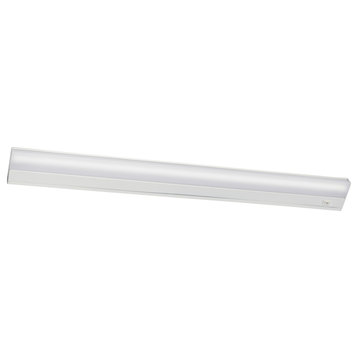
Direct-Wire Fluorescent 21Wby Kichler(22)
$72
Free Shipping
This 1 light, 34.5 inch, linear direct wire fluorescent accessory is accented with a clean, White finish.
Chances are, you’ve experienced the glow of a fluorescent lamp at least once during your lifetime. These are typically found in kitchens, garages, workplaces and businesses and tend to be more efficient than incandescent styles, lasting up to 20 times longer. They also provide ample lighting for large spaces and give off less heat than incandescent models. If you’re searching for fluorescent tubes for your lighting fixtures, be sure to note the size and wattage you need before making your purchase.
Your fluorescent lamp emits light by running an electrical current to the electrodes located at each end. This causes electrons to travel through the inert argon gas inside from one end of the tube to the other and back. While traveling, the electrons may collide with the small amount of mercury also inside, which causes the atoms to become excited and increases the energy levels of the electrons. Once the electrons return to their original energy level, they release light photons.
It’s important to note the size of the tube light you’re replacing to ensure you pick up a matching bulb. Though they may all seem similar, they can come in a number of different sizes. You can determine the size of an existing bulb by looking at its designation, which may resemble the following format: “F30T12/CW/RS.” Some variations may occur, but typically the format can be deciphered into the following meanings:
• F: Fluorescent; “FC” denotes a circular shape, while “FB” or “FU” denotes an U shape.
• 30: Rated nominal wattage.
• T: Shape, as in “T” for “tube.”
• 12: Diameter in eighths of an inch, or 12/8 inches (or 1 ½ inches) in diameter.
• CW: Temperature color; in this case meaning “cool white.”
• RS: Mode of starting; in this case a rapid-start lamp. A high-output rapid-start lamp will be designated “HO,” a very high-output will typically be designated “VHO,” and a preheat or an instant-start lamp will not have a designation.
• T2 / ¼ inch: The T2 size is extremely slim. The fitting at each end of the tube lacks the protruding pins that are typically found on larger sizes.
• T4 / ½ in.: These are typically used in slim lamps.
• T5 / ⅝ in.: Newer, more efficient versions of this size introduced in the 1990s have replaced the original styles from the 1950s and earlier years.
• T8 / 1 in.: These have become more common since the 1980s and may be referred to as the standard size.
• T9 / 1⅛ in.: Designated for circular fluorescent tubes.
• T12 / 1½ in.: This size is no longer being produced due to upgraded federal energy-efficiency standards. If you have a fixture that uses a T12 bulb, you may try using the newer T8 size; however, it’s more than likely the new T8 bulb will simply burn out after three or four uses. Instead, it’s recommended that your old fixture be upgraded to accommodate the new, more efficient bulbs on the market today. This may seem like a headache but could result in lower energy costs over the long run, since newer fluorescent lamp models are up to 40 percent more efficient.
The temperature of your lights refers to the range of color attributed to the light they emit. This varies from a warm white to a cool, daylight-like white. The temperatures are measured in degrees Kelvin (°K), and you can see which ones result in what lighting effects here:
• 6,500 °K – Cool daylight: This is typically used only in special daylight lamps, as it’s extremely white.
• 6,000 °K – Daylight: If you want your fluorescent light bulbs to simulate natural daylight, this is the temperature to choose.
• 4,000 °K – Cool white: You might associate this color with a hospital or clinic.
• 3,500 °K – White: This is the standard temperature and color.
• 3,000 °K – Warm white: Similar to the color output of a halogen lamp, though it seems to be whiter than an incandescent lamp.
• 2,700 °K – Very warm white: If you want a cozier ambience, the light of this temperature closely resembles the warm, white glow emitted by an incandescent bulb.
How do fluorescent tubes work?
Your fluorescent lamp emits light by running an electrical current to the electrodes located at each end. This causes electrons to travel through the inert argon gas inside from one end of the tube to the other and back. While traveling, the electrons may collide with the small amount of mercury also inside, which causes the atoms to become excited and increases the energy levels of the electrons. Once the electrons return to their original energy level, they release light photons.
What size does my tube light need to be?
It’s important to note the size of the tube light you’re replacing to ensure you pick up a matching bulb. Though they may all seem similar, they can come in a number of different sizes. You can determine the size of an existing bulb by looking at its designation, which may resemble the following format: “F30T12/CW/RS.” Some variations may occur, but typically the format can be deciphered into the following meanings:
• F: Fluorescent; “FC” denotes a circular shape, while “FB” or “FU” denotes an U shape.
• 30: Rated nominal wattage.
• T: Shape, as in “T” for “tube.”
• 12: Diameter in eighths of an inch, or 12/8 inches (or 1 ½ inches) in diameter.
• CW: Temperature color; in this case meaning “cool white.”
• RS: Mode of starting; in this case a rapid-start lamp. A high-output rapid-start lamp will be designated “HO,” a very high-output will typically be designated “VHO,” and a preheat or an instant-start lamp will not have a designation.
• T2 / ¼ inch: The T2 size is extremely slim. The fitting at each end of the tube lacks the protruding pins that are typically found on larger sizes.
• T4 / ½ in.: These are typically used in slim lamps.
• T5 / ⅝ in.: Newer, more efficient versions of this size introduced in the 1990s have replaced the original styles from the 1950s and earlier years.
• T8 / 1 in.: These have become more common since the 1980s and may be referred to as the standard size.
• T9 / 1⅛ in.: Designated for circular fluorescent tubes.
• T12 / 1½ in.: This size is no longer being produced due to upgraded federal energy-efficiency standards. If you have a fixture that uses a T12 bulb, you may try using the newer T8 size; however, it’s more than likely the new T8 bulb will simply burn out after three or four uses. Instead, it’s recommended that your old fixture be upgraded to accommodate the new, more efficient bulbs on the market today. This may seem like a headache but could result in lower energy costs over the long run, since newer fluorescent lamp models are up to 40 percent more efficient.
What does temperature have to do with my fluorescent lights?
The temperature of your lights refers to the range of color attributed to the light they emit. This varies from a warm white to a cool, daylight-like white. The temperatures are measured in degrees Kelvin (°K), and you can see which ones result in what lighting effects here:
• 6,500 °K – Cool daylight: This is typically used only in special daylight lamps, as it’s extremely white.
• 6,000 °K – Daylight: If you want your fluorescent light bulbs to simulate natural daylight, this is the temperature to choose.
• 4,000 °K – Cool white: You might associate this color with a hospital or clinic.
• 3,500 °K – White: This is the standard temperature and color.
• 3,000 °K – Warm white: Similar to the color output of a halogen lamp, though it seems to be whiter than an incandescent lamp.
• 2,700 °K – Very warm white: If you want a cozier ambience, the light of this temperature closely resembles the warm, white glow emitted by an incandescent bulb.
Item 1 of 3








